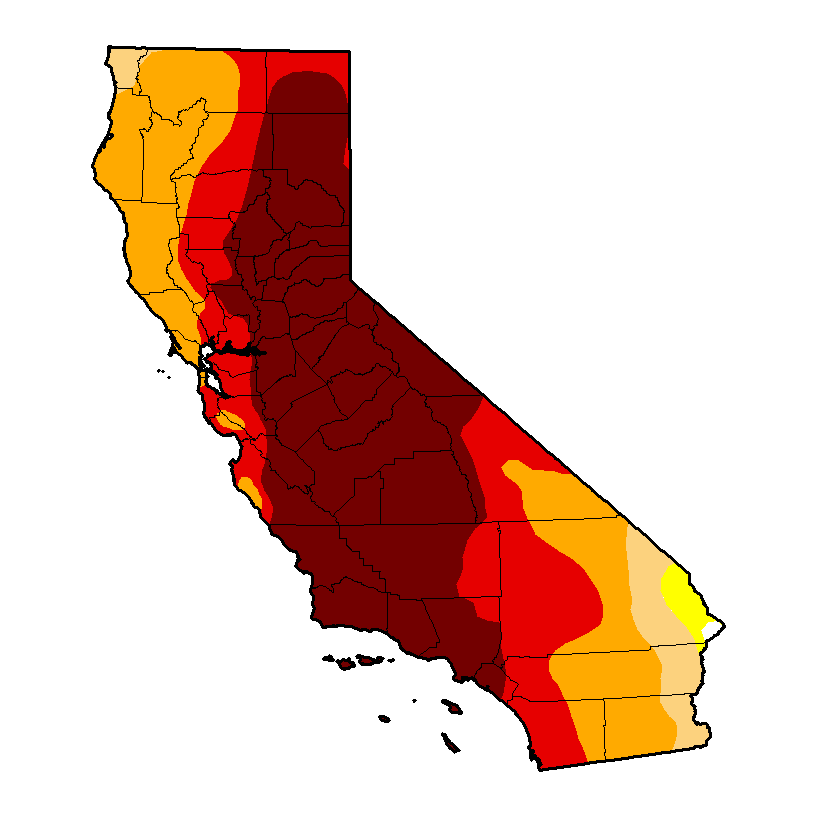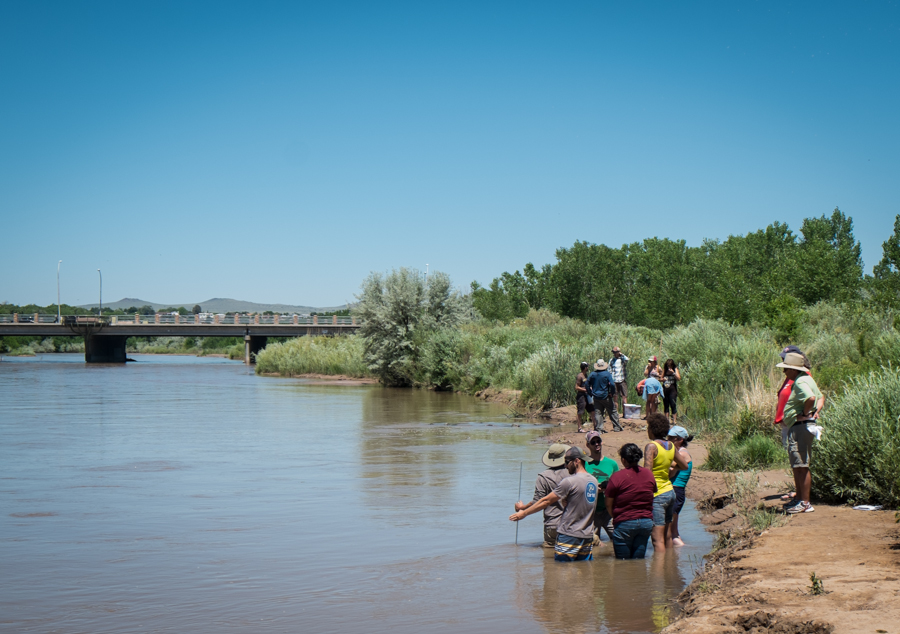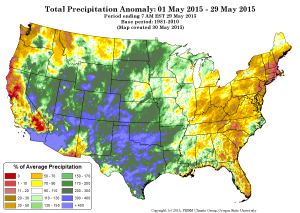Tom Curwen has a great story in today’s Los Angeles Times of the sort that I’d like to see more of – beyond “OMG California is toast” drought coverage to look at what works in the state’s water management, what sort of adaptive capacity exists in the places where water is not running out. Which, it turns out and breathless headlines notwithstanding, is much of the state:
National headlines ask: “The End of California?” News stories track the diminishing snowpack and disappearing reservoirs, and a small fish in the Delta is scapegoated, almond growers and consumers are shamed and the mythology of Western resolve is questioned.
The crisis has led many to wonder whether the state has lost its historic resilience.
But the drama hides reality and for those who have studied California’s long relationship with its water, the drought is serious but hardly a disaster.
“The sky is not falling,” said Jeffrey Mount, senior fellow with the Public Policy Institute of California.

Scary drought map that feeds the “bad news” meme, only it really is bad!
Distance from my former career (newspaper journalism) has made more obvious something that bothered me while I was in it – the bias toward the bad. The incentives are deeply embedded in the newsroom culture – the knowledge that “gotcha” and failings and trouble are more likely to get you onto the front page, which is the currency of newsroom status (if not financial reward – the jobs mostly pay shit). A friend today shared an interesting bit of research that offers (for me, at least) a fresh explanation. It’s “You get what you want: A note on the economics of bad news“, by Jill McCluskey and colleagues (Information Economics and Policy Volume 30, March 2015):
In a framework where news is informative and consumers are risk averse, diminishing marginal utility implies that information about a negative income shock is more valuable than information about a positive shock, which leads to disproportionate reporting of bad news.
Seems like a reasonable model that could explain a quip from one of my editors that always bothered me: “We don’t write about planes that don’t crash.” I get that writing about the planes that crash is really important, diminishing marginal utility of information and all, but the fact that most planes don’t crash seems important as well. To only write about the crashing ones is to mislead.
Matt Stevens of the Los Angeles Times, who’s been doing a lot of really good drought coverage, had a viral story last month that captured the dilemma – California water officials deliver sobering facts on depleted wells. State water officials had told legislators that 1,900 California wells had gone dry. As has happened repeatedly in California drought coverage, Stevens zeros in on Tulare County, in California’s Central Valley:
More than half of the dry wells are in Tulare County, southeast of Fresno, state officials said. Most of the dry wells there are within the community of East Porterville, where hundreds of residents have gone without running water and volunteers have delivered emergency supplies.
But Stevens also points out that California has between 1 million and 2 million wells. So (contrary to a Times copy editor’s mistaken math) somewhere between 99.8 percent and 99.9 percent of California’s wells haven’t gone dry. I’ve talked about the Porterville problem before (and before that, when it was drought in Texas in 2012, the Spicewood Beach problem – if there’s just one place running out water, it’ll get a lot of media attention). Don’t get me wrong. If I was in California doing journalism, I’d be doing Porterville. In New Mexico in 2013, I wrote about Maxwell, which was our East Porterville/Spicewood Beach. But in retrospect, I realized I’d done it badly, and felt a need to come back and write another story to clean up the mess.
The question of what is going right, or at least not going wrong, in those 99-plus percent of not-dry wells seems like a critical question. What distinguishes East Porterville from the many other Central Valley communities that haven’t run out of water?
Curwen’s story offers a version of this, taking readers down into the weeds to understand the formation of the Santa Ana River Watershed Project Authority, one of a zillion institutional widgets that have evolved over the years to manage California’s increasingly scarce supplies of water. Things are tight everywhere in California, but most places where the water is not running out, which are most places in California, have a story like the Santa Ana.
It is in those myriad details that we’ll understand where future failures loom and how to avoid the next East Porterville.



